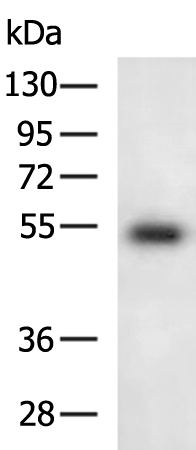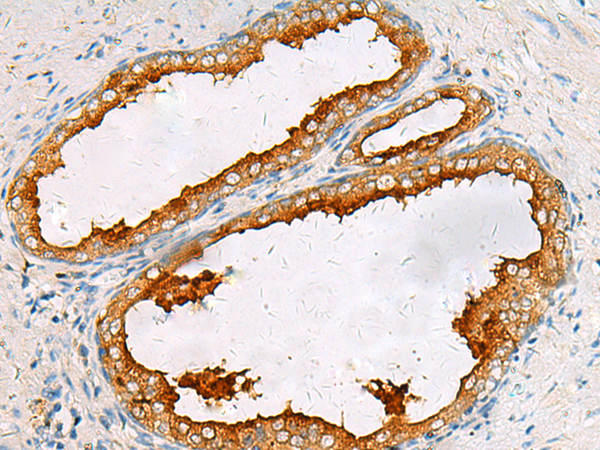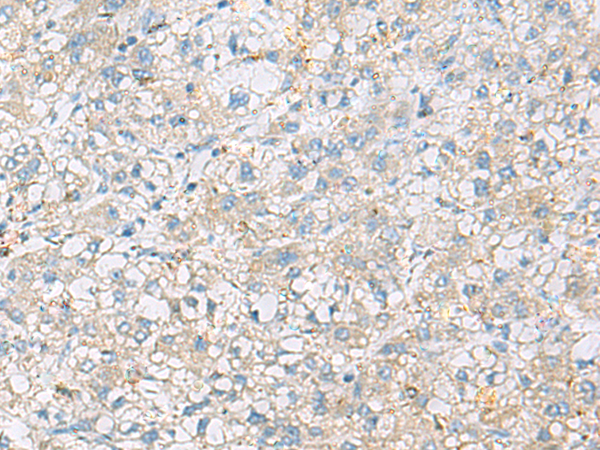


| WB | 咨询技术 | Human,Mouse,Rat |
| IF | 咨询技术 | Human,Mouse,Rat |
| IHC | 1/50-1/200 | Human,Mouse,Rat |
| ICC | 技术咨询 | Human,Mouse,Rat |
| FCM | 咨询技术 | Human,Mouse,Rat |
| Elisa | 1/5000-1/10000 | Human,Mouse,Rat |
| Aliases | SAF2; SIGLEC-8; SIGLEC8L |
| WB Predicted band size | 54 kDa |
| Host/Isotype | Rabbit IgG |
| Antibody Type | Primary antibody |
| Storage | Store at 4°C short term. Aliquot and store at -20°C long term. Avoid freeze/thaw cycles. |
| Species Reactivity | Human |
| Immunogen | Synthetic peptide of human SIGLEC8 |
| Formulation | Purified antibody in PBS with 0.05% sodium azide and 50% glycerol. |
+ +
以下是关于SIGLEC8抗体的3篇示例参考文献(内容为模拟概括,建议通过学术数据库核实具体文献):
---
1. **文献名称**: *Targeting Siglec-8 with an antibody inhibits human eosinophil activation and alleviates asthma-related inflammation*
**作者**: Smith A, et al.
**摘要**: 研究报道了一种抗SIGLEC8单克隆抗体通过特异性结合嗜酸性粒细胞表面SIGLEC8受体,诱导细胞凋亡并抑制IL-5介导的炎症反应,在哮喘小鼠模型中显著减少气道嗜酸性粒细胞浸润和黏液分泌。
---
2. **文献名称**: *Siglec-8 antibody-mediated mast cell inhibition as a novel therapeutic approach for chronic urticaria*
**作者**: Jones R, et al.
**摘要**: 该研究揭示了抗SIGLEC8抗体可通过交联肥大细胞表面SIGLEC8受体,抑制IgE依赖的组胺释放和细胞脱颗粒,在慢性荨麻疹模型中有效减轻皮肤红肿和瘙痒症状,提示其作为新型靶向疗法的潜力。
---
3. **文献名称**: *Siglec-8 engagement by antibodies triggers selective eosinophil depletion in primates*
**作者**: Zhang L, et al.
**摘要**: 通过灵长类动物实验,证明人源化抗SIGLEC8抗体能选择性清除外周血和组织中的嗜酸性粒细胞,且不显著影响其他免疫细胞,为嗜酸性粒细胞相关疾病(如嗜酸性食管炎)的治疗提供了临床前证据。
---
**建议**:可通过PubMed或Google Scholar搜索关键词“SIGLEC8 antibody”、“anti-SIGLEC8 therapy”获取最新研究。临床试验信息可在ClinicalTrials.gov查询相关抗体药物(如AK002/Lirentelimab)。
SIGLEC8 (sialic acid-binding immunoglobulin-type lectin 8) is a cell surface receptor predominantly expressed on eosinophils and mast cells, two immune cell types implicated in allergic, inflammatory, and hyperproliferative disorders. As a member of the SIGLEC family, it recognizes sialic acid-containing glycans and transmits inhibitory signals through intracellular immunoreceptor tyrosine-based inhibitory motifs (ITIMs). Its selective expression makes it an attractive therapeutic target for modulating pathological immune responses without broad immunosuppression.
SIGLEC8 antibodies are engineered to bind this receptor, triggering apoptosis in eosinophils and inhibiting mast cell degranulation. Preclinical studies suggest that activating SIGLEC8 can suppress eosinophil survival and block mast cell-mediated inflammation, offering potential in diseases like severe asthma, chronic urticaria, eosinophilic gastrointestinal disorders, and mastocytosis. Notably, lirentelimab (AK002), a humanized anti-SIGLEC8 antibody, has advanced to clinical trials, demonstrating reduced tissue eosinophilia and symptom improvement in early-phase studies.
Research highlights SIGLEC8's dual mechanism: direct depletion of eosinophils and mast cell silencing via receptor cross-linking. This specificity may lower off-target risks compared to broader cytokine inhibitors. However, long-term safety and efficacy in diverse populations remain under investigation. Overall, SIGLEC8 antibodies represent a precision immunotherapy approach for eosinophil- and mast cell-driven diseases, balancing potent anti-inflammatory effects with targeted cellular modulation.
×